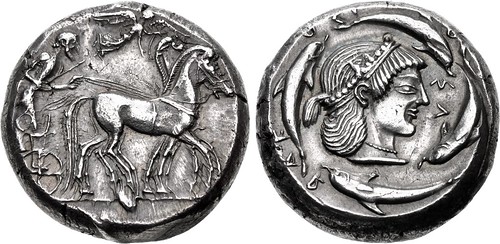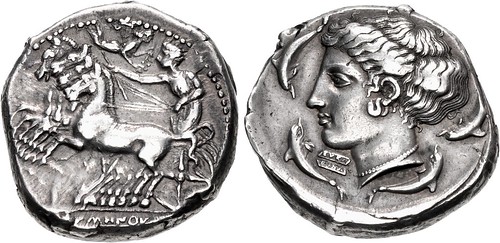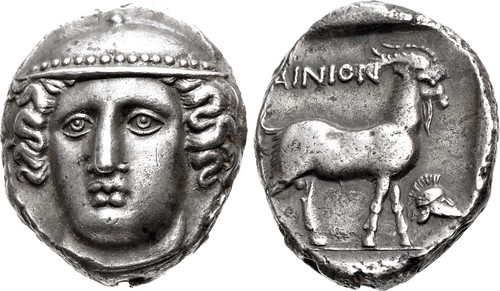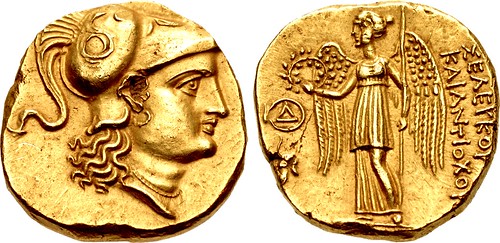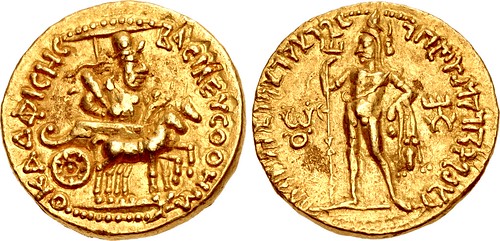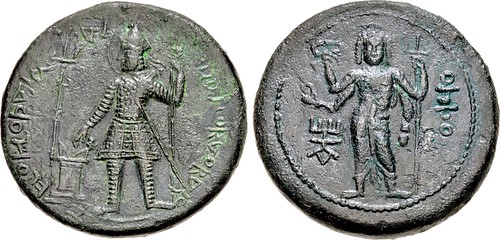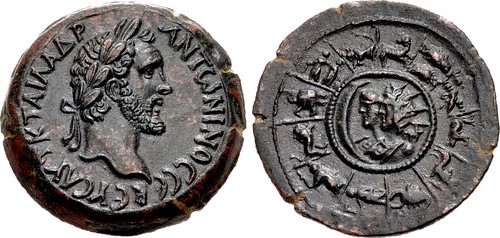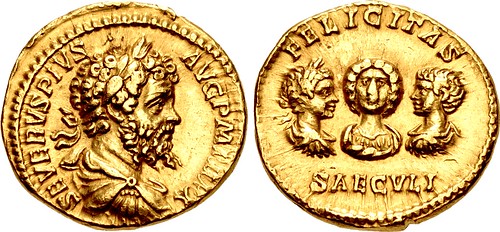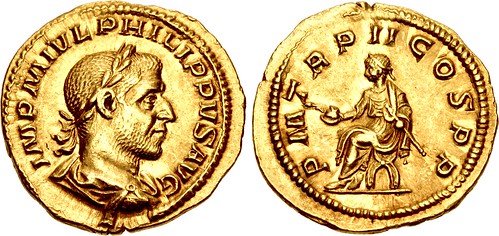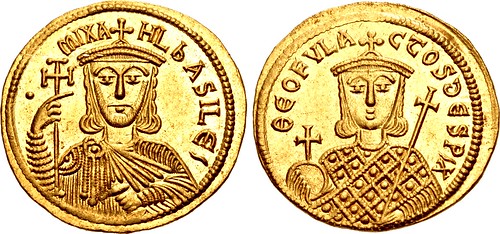
PREV ARTICLE
NEXT ARTICLE
FULL ISSUE
PREV FULL ISSUE
CLASSICAL NUMISMATIC GROUP AUCTION 117Here's the press release for the CNG spring sale. Some beautiful coins here. -Editor Classical Numismatic Group, LLC is proud to present CNG Feature Auction 117, a Live Online Sale closing Wednesday & Thursday, 19-20 May 2021, from our Lancaster, Pennsylvania office. This sale offers 1158 lots with a presale estimate of $2.15 million. Our annual spring sale features Greek, Celtic, Oriental Greek, Central Asian, Roman Provincial, Roman Republican and Imperatorial, and Roman Imperial coinage. Additionally, there are featured selections of Byzantine, Early Medieval and Islamic, Early Dated Coinage, World coinage and medals, United States coinage and medals, British coinage and medals, antiquities, and reference books. CNG 117 is highlighted by a number of collections and individual rarities, which make up the majority of coins on offer:
Catalogs for CNG 117 have been mailed to our active mailing list and bidding is open on the site. Some of the individual highlights from CNG 117 are:
Exceptional Tetradrachm from the Rosen Collection
Lot 49 –SICILY, Syracuse. Hieron I 478-466 BC. AR Tetradrachm (23.5mm, 17.39 g, 2h). Struck circa 478-475 BC. Charioteer, holding kentron in right hand, reins in left, driving quadriga right; above, Nike flying right, crowning horses with open wreath held in both hands / Head of Arethousa right, wearing pearl tainia and necklace; S?-(retrograde R)-AK-OSI-O[N] and four dolphins around. Boehringer Series VIIIb, 178 (V79/R123); HGC 2, 1306; SNG ANS 55 (same dies); de Luynes 1150 (same dies); Andersen 29.1 and 32.1 (this coin). Attractive light iridescent tone, a couple of minor die breaks. EF. Fine style. Estimated at $20,000 From the Apollo to Apollo Collection. Ex LHS 102 (29 April 2008), lot 82; Leu 81 (16 May 2001), lot 103; Jonathan P. Rosen Collection (Münzen und Medaillen AG 72, 6 October 1987), lot 460; Lanz 34 (25 November 1985), lot 87.
Signed by Eumenos and Eukleidas
Lot 51–SICILY, Syracuse. Second Democracy. 466-405 BC. AR Tetradrachm (24mm, 17.37 g, 1h). Obverse die signed by Eumenos, reverse die signed by Eukleidas. Struck circa 415-409 BC. Charioteer, holding kentron in extended right hand and reins in left, driving fast quadriga left; above, Nike flying right, crowning charioteer with laurel wreath held in both hands; [E]-VMHNOV in exergue / Head of Arethousa left, wearing hoop earring and pearl necklace; [SYPAKOSIOS above], EVK?/EI?A in two lines on diptych below chin, four dolphins swimming around. Fischer-Bossert, Coins 24a (V9/R16 – this coin); Tudeer 24; HGC 2, 1328; SNG ANS 259; SNG Lloyd 1368; BMC 193; Boston MFA 401–2 = Warren 371–2; Gillet 612; Hunterian 60; de Luynes 1207; Ognina 287; Rizzo pl. XLII, 13 (all from the same dies). Attractive even gray tone with light golden hues around the devices, a little die rust, minor lamination. Near EF. Estimated at $20,000 Ex Gasvoda Collection (Triton XXII, 8 January 2019), lot 142; Gorny & Mosch 240 (10 October 2016), lot 39; Triton XIX (5 January 2016), lot 53; Künker 226 (11 March 2013), lot 242; Numismatica Ars Classica 64 (17 May 2012), lot 722; Numismatica Ars Classica 52 (7 October 2009), lot 75; LHS 102 (29 April 2008), lot 88; Numismatica Ars Classica 29 (11 May 2005), lot 115. The magnificent artistic flowering in Sicily in the 5th century BC has its origins in times of great strife. By the middle of the century, the situation began to resemble that of Renaissance Italy, where local princes engaged in continual warfare among themselves while employing the finest artists and craftsmen of their time. The result was the patronizing of some of the most talented coin engravers in history. In Syracuse, by the late 5th century BC these engravers were proudly signing their work, preserving the names of Kimon, Euainetos, Eumenos, Sosion, Herakleidas, Eukleidas and others for posterity. Their handiwork included several collaborative efforts, including coins with obverse and reverse dies signed by different artists, as seen here. Indeed, Eukleidas was so proud of his effort, he carefully placed his signature on a small raised two-paneled plaque below his serene head of Arethousa.
Very Rare Ainos Tetradrachm
Lot 65–THRACE, Ainos. Circa Circa 372/1-370/69 BC. AR Tetradrachm (21mm, 15.69 g, 12h). Head of Hermes facing slightly left, wearing petasos with pelleted rim / Goat standing right; AINION above; to right, crested Corinthian helmet right; all within incuse square. May, Ainos 411–3 var. (unlisted dies); AMNG II 377; HGC 3, 1278; SNG Ashmolean 3552; Traité IV 1509, pl. CCCXLV, 18. EF, deeply toned. Very rare issue. Estimated at $20,000 Ex Gasvoda Collection (Triton XXII, 9 January 2019) lot 163; Friend of a Scholar Collection (CNG inventory 405840); Münzen und Medaillen AG 68 (15 April 1986), lot 204.
Unique Joint Reign Stater
Lot 263–SELEUKID EMPIRE. Seleukos I Nikator & Antiochos I Soter. Joint Reign, 294-281 BC. AV Stater (16mm, 7.06 g, 6h). In the types of Alexander III of Macedon. Indian standard. Aï Khanoum mint. Struck circa 284-280 BC. Head of Athena right, wearing hoop earring, necklace, and triple-crested Corinthian helmet adorned with a coiled serpent / SE?EYKOY KAI ANTIOXOY, Nike standing left, holding wreath in extended right hand, cradling stylis in left arm; in left field, ?-in-circle above horned helmet or head of elephant left(?). Unpublished, but cf. SC 280.3a for a similar silver drachm also struck on the Indian standard. Lightly toned, a few small scrapes and faint doubling on obverse, minor flan flaw on reverse. EF. Unique. Estimated at $30,000 In 294 BC, Seleukos I made his son, Antiochos I, co-ruler. At the time, his domains stretched from Asia Minor to India, and Seleukos had spent most of the preceding decade in the west, at first fighting against Antigonos I Monophthalmos and later consolidating his gains by founding a number of cities throughout the Levant. This concentration on the west resulted in a degradation of Seleukid authority in the east, which culminated in a nationalist revolt in Persis in 295 BC, which became the first province to secede from the empire. It was likely this event that led Seleukos to elevate his son, whose new remit was to govern the eastern territories as his father's viceroy. Over the next fifteen years, Antiochos reestablished Seleukid authority in Persis, and extended to the Upper Satrapies the policy of consolidation that his father implemented in the west. During the coregency, many of the mints of the east began to strike coins in the name of Antiochos for at least some issues, while Seleukos's name was retained on others. However, at Aï Khanoum there is a multi-denominational series of silver coins struck on the lighter Indian standard that exceptionally depict the names of both kings (SC 279–282). The present stater, also struck on the Indian standard, is the first, and only known, gold stater for this series, and from the mint of Aï Khanoum during the reign of Seleukos I. This Indian weight standard series is still shrouded in mystery. Its specific purpose has been long debated, but likely has to do with the intended area of circulation and recipient of this coinage; it was probably intended for use in trade that was flowing toward India. However, one question that has not been addressed well is: Why was this the only instance of a coinage with the names of both kings? Certainly, Seleukos's name would be instantly recognizable to an Indian recipient, but his name was already on the issues of Aï Khanoum; it is Antiochos’s that was added. Perhaps it was necessary from a diplomatic perspective for promoting Antiochos’s position, given that this was apparently a coinage specifically intended for trade outside the Empire? In any case, this is the only instance during Antiochos’s viceroyalty where this occurred, and it also is an irrefutable statement confirming the relationship of the two kings, not as senior and junior partners, but as co-rulers.
Very Rare Vima Kadphises Gold Dinar
Lot 367–INDIA, Kushan Empire. Vima Kadphises. Circa AD 113-127. AV Dinar (21mm, 8.05 g, 12h). Main mint in Baktria. BACI??YC OOHM O KA?FICHC, diademed and crowned figure of Vima Kadphises, cradling club in left arm, seated right in canopied chariot drawn by pair of horses; miniature charioteer before Vima, holding whip / Maharajasa rajadirajasa loga’isvaraja maha’isvarasa vima kathpisasa in Kharosthi, ithyphallic Siva with two heads (mustached human and horned animal) standing facing, human head left, holding trident in right hand and water flask in left; left arm draped with animal skin; Buddhist Triratana (Three Jewels) to left; tamgha to right. Bopearachchi, Premiers, Série VII, 10 = Bopearachchi, Some 3 (same dies); MK 5 (O1/R1); ANS Kushan 265; Donum Burns –; Adams IV 2125 (same dies). Small earthen deposits on obverse. Good VF. Very rare. Estimated at $20,000 This dinar shows Vima Kadphises in a parasoled chariot, drawn by two horses. It is strikingly similar to a similar chariot (drawn by four horses), discovered among the Terracotta Army that was part of the tomb complex of the Chinese emperor Qin Shi Huang (259-210 BC). Initially, chariots served a military function. As weapons technology changed, making the chariot outdated, it continued to be used among the nobility as a means of transportation and a reflection of their wealth and power. For the Kushan rulers, use of this technology would not only have been familiar because of their Yueh-Chi ancestry, but also reflected their adaptation of various regional cultures.
Unique and Impressive Medallion
Lot 389–INDIA, Kushan Empire. Vasudeva I. Circa AD 190-230. Æ Medallion (50mm, 80.01 g, 12h). Main mint in Baktria (Balkh?). Middle phase. ÞA [ONA]NOÞAO BAO BA ZO [?] HO HOÞA[H]A (sic), Vasudeva, nimbate, standing facing, head left, sacrificing over altar and holding trident; trident to left / OhÞO, ithyphallic Siva with three heads standing facing, holding a garland or diadem, and vajra (thunderbolt) in upraised hands, lotus or flask in outstretched hand, and one hand lowered at side; tamgha to left. Cf. MK 509 (for obv. and rev. types; rev. with Nandi [dinar]) and MK 1001-3 (for obv. type; rev. with two-armed Siva and Nandi [tetradrachm]); ANS Kushan –; Donum Burns –; Göbl, Antike –; Zeno 118830 (this medallion). Dark green patina, some roughness and traces of smoothing, areas of stabilized green. VF. Unique and impressive. Estimated at $15,000 From the Archytas Collection. Ex Classical Numismatic Group 96 (14 May 2014), lot 640 (withdrawn for conservation); Triton XVI (8 January 3013), lot 673.
Extremely Rare ‘Zodiac Wheel’ – Finest Known
Lot 431–EGYPT, Alexandria. Antoninus Pius. AD 138-161. Æ Drachm (34.5mm, 24.71 g, 12h). Zodiac series. Dated RY 8 (AD 144/145). AYT K T AI? A?P ANT?NINOC C?B ?YC, laureate head right / Zodiac wheel, with “Aries” at the top, around an inner circle with the conjoined busts left of Helios and Selene (with their typical attributes); not dated. Köln –; Dattari (Savio) 2983 var. (obv. bust type); K&G –; RPC IV.4 Online 16967; Emmett 1705.8 (R5). Attractive dark green surfaces with touches of red, hint of smoothing on obverse. EF. Extremely rare “Zodiac wheel” variety, none in CoinArchives, and the authors of RPC IV Online cite only one specimen, which appeared in the Leo Hamburger sale of 19 October 1925, as lot 992 (the Niklovitz collection). Our coin is certainly the finest known for this extremely rare variety, and overall one of the finest known Zodiac wheel types from Alexandria. Estimated at $20,000 The Great Sothic Cycle was a calendrical cycle based on the heliacal rising in July of the star Sirius (known to the Greeks as Sothis) and lasting approximately 1460 years. According to ancient Egyptian mythology, in a Golden Age, the beginning of the flooding of the Nile coincided exactly with the rising of Sirius, which was reckoned as the New Year. Only once every 1460 years did Sirius rise at exactly the same time. Thus, the coincidence of this along with the concurrent beginning of the flooding of the Nile gave the event major cosmological significance by heralding not just the beginning of a new year, but also the beginning of a new eon. This event also was thought to herald the appearance of the phoenix, a mythological bird that was reborn every 500 to 1000 years out of its own ashes. According to one version of the myth, each new phoenix embalmed its old ashes in an egg of myrrh, which it then deposited in the Egyptian city of Heliopolis. So important was the advent of the new Great Sothic Cycle, both to the realignment of the heavens and its signaling of the annual flooding of the Nile, that the Egyptians celebrated it in a five-day festival, which emphasized the important cosmological significance. In the third year of the reign of Antoninus Pius (AD 139/40), a new Great Sothic Cycle began. To mark this event, the mint of Alexandria struck an extensive series of coinage, especially in large bronze drachms, each related in some astrological way to the reordering of the heavens during the advent of the new Great Sothic Cycle. This celebration would continue throughout Pius’ reign, with an immense output of coinage during the eighth year of his reign in Egypt, which included this coin type, part of the Zodiac series.
The Severan Dynasty at a Glance
Lot 573–Septimius Severus, with Julia Domna, Caracalla, and Geta. AD 193-211. AV Aureus (19.5mm, 7.19 g, 6h). Rome mint. Struck AD 202. SEVERVS PIVS AVG P M TR P X, laureate, draped, and cuirassed bust right / FELICITAS above, SAECVLI below, draped bust of Julia Domna facing between a laureate, draped, and cuirassed bust of Caracalla right vis-à-vis a bareheaded, draped, and cuirassed bust of Geta left. RIC IV 181b; Calicó 2590 (same dies as illustration); BMCRE 379; Biaggi 1125 (same dies). Lightly toned, underlying luster, a few light marks and scratches, typical weakness to Domna’s nose. Near EF. Rare and popular type. Estimated at $30,000 Ex Provence Collection. The reign of Septimius Severus was unique for the production of a remarkable series of coins depicting various members of the Imperial family in a variety of combinations, many of great beauty and exceptional iconographic interest. Among the rarest of this series is this beautiful aureus, which combines a forceful obverse portrait of Severus with a facing bust of his wife Julia Domna, between confronting busts of their two sons Caracalla and Geta. The legend FELICTAS SAECVLI, “happy age,” completes the propaganda message of a secure new dynasty. In reality, the dysfunctional family dynamic led to a very brief run for the Severan clan.
Rare Philip I Aureus
Lot 593–Philip I. AD 244-249. AV Aureus (20.5mm, 4.32 g, 6h). Rome mint. 2nd emission, AD 245. IMP M IVL PHILIPPVS AVG, laureate, draped, and cuirassed bust right / P M TR P II COS P P, Philip I, laureate and togate, seated left on curule chair, holding globe in right hand and short scepter in left. RIC IV 2; Bland, Gold 14 (dies PI 11/TRP II 03); Calicó 3254; Biaggi 1381. Lustrous, a few light marks. Near EF. Rare. Estimated at $15,000
Michael I: From Emperor to Monk
Lot 703–Michael I Rhangabe, with Theophylactus. 811-813. AV Solidus (21mm, 4.40 g, 6h). Constantinople mint. • mIXA HL bASIL?’, crowned and draped facing bust of Michael, holding globus cruciger in right hand and akakia in left / T?OFVLA CtOS ??SP´, crowned facing bust of Theophylactus, wearing loros, holding globus cruciger in right hand and cross-tipped scepter in left; X at end of legend. DOC 1a.1-4 (same dies); Füeg 1.B; SB 1615. Choice EF. Struck on an oversized flan, beautifully struck. Rare. Estimated at $20,000 A high court official, Michael Rhangabe seized power when Nicephorus I was killed in battle. Michael raised his eldest son Theophylactus as co-emperor and reversed the iconoclast policies of his predecessor. In 812, he recognized Charlemagne as emperor of the West in return for Venice returning to Byzantine control; the Venetians, however, ignored the edict. Early in 813, Michael mounted a campaign against the Bulgarians, but they routed his army. In the aftermath, Michael abdicated and named the general Leo V as his successor. Michael took monastic vows and died peaceably as a monk 30 years later. His coinage in all metals is very rare.
***************
Printed catalogs for CNG 117 are now available. To order the catalog, please call our U.S. office at (717) 390-9194. Catalogs have been mailed to customers on CNG’s active mailing list. Prospective bidders may also view the virtual catalogs at https://issuu.com/cngcoins/docs/cng_117_virtual_catalog?fr=sMGZhNjIwNDkyNDU. The sale can be viewed online at auctions.cngcoins.com, sixbid.com, and numisbids.com. Wayne Homren, Editor The Numismatic Bibliomania Society is a non-profit organization promoting numismatic literature. See our web site at coinbooks.org. To submit items for publication in The E-Sylum, write to the Editor at this address: whomren@gmail.com To subscribe go to: https://my.binhost.com/lists/listinfo/esylum All Rights Reserved. NBS Home Page Contact the NBS webmaster 
|
